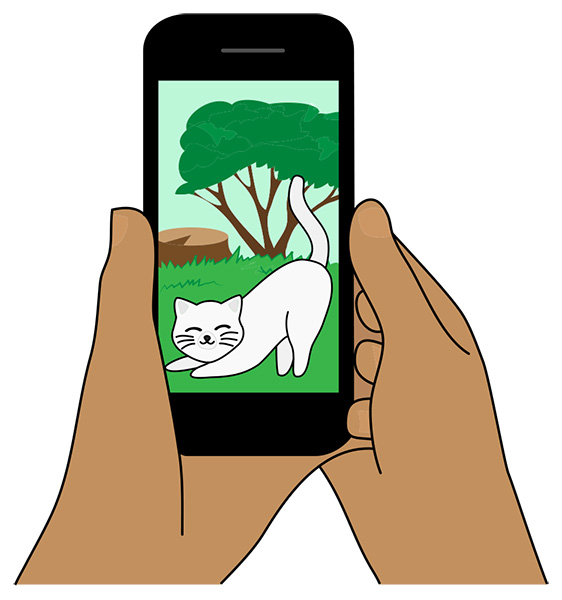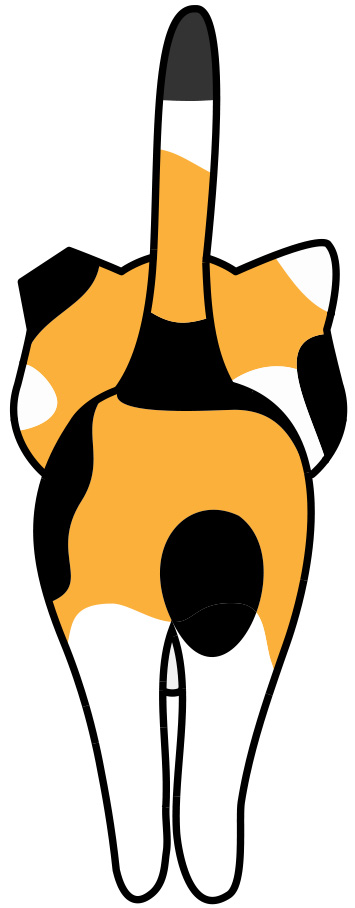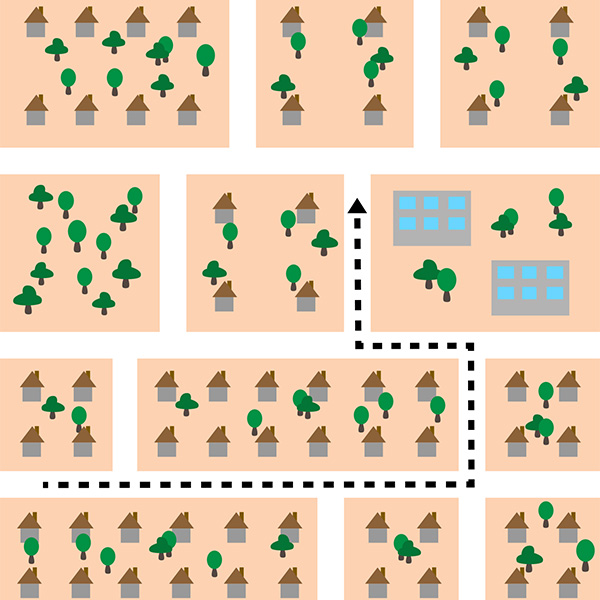How Kitizen Science Works
Kitizen Science is a groundbreaking, volunteer-driven research project based on a modified version of the Wildbook citizen science platform paired with our custom data collection smartphone app. Here are the five basic steps of how our research works:
Step 1: In partnership with a spay/neuter organization, we define a target area and a control area to monitor. We collect data from the organization about the number of cats they have sterilized, as well as conduct opinion surveys of human residents regarding owned cats and attitudes towards free-roaming cats.
Step 2: During cat survey periods, volunteers using our smartphone app follow a walking route on a map and photograph any cat they see outdoors in the target and control areas. These observations are uploaded securely into our citizen science platform.
Step 3: Submissions are processed by online volunteers who assign cat attributes and match cats, distilling a large collection of photos and information into useful data.
Step 4: Our population biologist collaborator analyzes this data using mark-recapture modeling methods to produce a rigorous, science-based population estimate.
Step 5: This process repeats annually for at least five years after a baseline year. We will close out work in a location by administering our human resident survey a second time.
Can't artificial intelligence identify cats?
It will probably be possible in a decade or two, but not yet. Wildbook's other projects use artificial intelligence (also known as machine learning) to identify and match wild animals, but this type of technology doesn't work with domestic cat photos. It may sound counterintuitive, but cats are too different for computer algorithms to be able to successfully compare and identify them. A jaguar with her spotted coat pattern can more easily be compared against the precise spacing of spots on other jaguars, but a grey cat and an orange cat don't even look like the same species to an artificial intelligence tool. While Wildbook and custom features we have added to our program help us to cut down on some work through the use of artificial intelligence, cat identification still needs to be done by humans.
 What is citizen science?
What is citizen science?
Citizen science projects bring together researchers and the community to study a topic of interest by involving volunteers in roles such as data collection and data organization. These projects not only reduce the cost of conducting research, but also engage the public in the scientific process around issues that matter to them. Many of the largest and longest-running citizen science programs are about monitoring songbirds (like the Christmas Bird Count), but the citizen science framework is also used to learn about a variety of other issues: exploring astronomy, folding proteins, tracking the decline of bees and insects, testing air and water quality, studying coral reef bleaching, timing when wildflowers bloom, and more.
Kitizen Science was founded to use citizen science methods to monitor the impacts of spay/neuter programs on free-roaming cat populations in partnerships with spay/neuter organizations.
How can you know the size of a cat population?
 If you operate a spay/neuter program, you may have heard that you can roughly estimate the cats in an area by taking the human population and dividing it by some number. That's a good way to make a ballpark guess at how many animals your program might serve when you are applying for your first grants, but this ratio method is not meant for conducting a scientific population estimate or monitoring changes in cat populations over time.
If you operate a spay/neuter program, you may have heard that you can roughly estimate the cats in an area by taking the human population and dividing it by some number. That's a good way to make a ballpark guess at how many animals your program might serve when you are applying for your first grants, but this ratio method is not meant for conducting a scientific population estimate or monitoring changes in cat populations over time.
Unless you are working in a small, fairly contained area like an RV park where you can conduct a true census (identify every single cat), it is not possible to count all the cats in a large area. Cats aren't trees: they move and hide, and won't line up and sit still to be counted. So, how can we track the number of free-roaming cats in an area if a census isn't possible?
Thankfully, there was no need for us to reinvent the wheel. Assessing an animal group's size is one of the fundamental tools of a wildlife population ecologist's toolkit. This is how conservation researchers estimate things such as the remaining population sizes of threatened and endangered species.
Kitizen Science has been learning from decades of research on wildlife population estimation to create a first-of-its-kind photographic mark-recapture system (also referred to as photographic mark-resight or photographic capture-recapture) that works at the perfect middle ground of being highly scientifically rigorous but still simple enough for volunteers to do.
What is photographic mark-recapture?
Think back to the problem preventing us from conducting a cat census: cats move around. While this might seem like a barrier, it is actually the thing that makes photographic mark-recapture work. Fifty years ago, mark-recapture would mean physically capturing some animals in a population, marking them in a visible way, releasing these animals to mingle with others, capturing some members of this population again, and counting how many were previously marked. From that information, you can estimate how many animals are in the larger population. Here is a simple example: you trap 20 cats and spray them with green dye, then set them free to move around in the local cat population. The next day, you come back and trap 20 cats again, and 10 out of 20 of these cats were dyed. From that, you can infer that there are about 40 cats in the area, since it appears that the 20 cats you sprayed with dye make up about half of the population.

Mark-recapture population estimation today involves a lot of complicated statistics, but this example conveys the basic principle on which those methods are based.
Kitizen Science uses photographic mark-recapture because it does not require stressful capturing or handling of animals. Instead of a cat being "marked" physically, it is "marked" by being identified as a unique individual based on its natural coat patterns. (Animal welfare is a top priority of Kitizen Science, and our research methods are completely non-invasive. The cats being studied won't even realize it!) Not all cats in an area need to be uniquely identifiable, such as solid black cats.
 What if the information you collect gets into the wrong hands?
What if the information you collect gets into the wrong hands?
Free-roaming cat caretakers can be wary outsiders in order to protect the safety of cats in their care. We want to assure the cat advocate community that Kitizen Science is not seeking to create a database of private information about cats and colonies. We understand your concerns and have carefully designed our program to address them by collecting the least amount of information possible to accomplish our goals.
In our connected world, data you thought were private can suddenly become public. There are two basic ways of dealing with private information. There is privacy by policy, where an entity collects private information and has terms and conditions that promise to not release private information. However, this is based on trust, shifting corporate policies, and is still vulnerable to hackers and accidental leaks. By contrast, there is privacy by design, which means that private information is not collected in the first place, so there is nothing highly sensitive to be leaked or stolen. Kitizen Science has been created as the latter: privacy by design.
No entity collecting private information can guarantee that the data could never be stolen or misused, but we strive to prevent the exposure of private information about cats and their caretakers by never collecting it. We do not want to know about colony locations, names of caretakers, locations of feeding stations, veterinary medical records, or anything that is private or sensitive. Kitizen Science only collects information that any person could gather by walking down a public street: photos and locations of cats at moments in time. The "magic" of Kitizen Science is in our research methods and what we can do with study design and statistical modeling.
To further aid in protecting the privacy of human communities in which we work, our citizen science software has a custom artificial intelligence tool that applies a blur filter to potentially private information such as human faces, license places, and house numbers - similar to what you see in Google Street View. Online volunteers processing cat survey submissions cannot access a cat's location coordinates, and it would be difficult to determine where a given photo was taken.